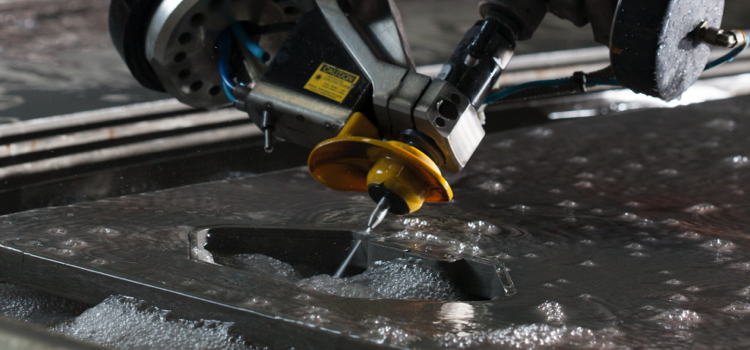MEGA Tech ขอนำเสนอเทคโนโลยีวอเตอร์เจ็ทเป็นหนึ่งในวิธีการตัดเฉือนที่อเนกประสงค์ที่สุดและมีความก้าวหน้ารวดเร็วที่สุด รวมทั้งถูกนำมาใช้กับงานผลิตในอุตสาหกรรมต่างๆ ทั่วโลก ระบบวอเตอร์เจ็ทสามารถใช้แทนหรือเสริมกับวิธีการตัดเฉือนอื่นๆ เช่น การกัด การตัดด้วยเลเซอร์ การตัดเฉือนแบบ EDM พลาสม่า และการเซาะร่อง
เทคโนโลยีวอเตอร์เจ็ทช่วยพลิกโฉมหน้าของอุตสาหกรรมการผลิต เนื่องจากให้ทั้งความอเนกประสงค์และประสิทธิภาพสำหรับสายการผลิตทุกรูปแบบ นวัตกรรมการตัดเฉือนรูปแบบใหม่นี้เป็นการใช้น้ำแรงดันสูงผสมวัสดุขัด เพื่อตัดวัสดุชนิดต่างๆ อย่างแม่นยำ ช่วยให้สามารถพลิกโฉมอุตสาหกรรมต่างๆ ได้ทุกแขนง ตั้งแต่อากาศยานไปจนถึงงานศิลปะ บทความนี้จะพาคุณไปรู้จักกับการใช้งานและข้อดีของเทคโนโลยีวอเตอร์เจ็ทที่ใช้ในสายการผลิตของอุตสาหกรรมต่างๆ

รู้จักกับเทคโนโลยีการตัดด้วยวอเตอร์เจ็ท
เทคโนโลยีวอเตอร์เจ็ทถูกคิดค้นขึ้นเป็นครั้งแรกในช่วงทศวรรษ 1970 โดย Flow International Corporation จากนั้น ได้มีการปรับปรุงและพัฒนาอย่างต่อเนื่องจนกลายเป็นเทคโนโลยีที่มีความซับซ้อนและสามารถรองรับความต้องการได้ทุกอุตสาหกรรม เครื่องตัดระบบวอเตอร์เจ็ทใช้พลังของน้ำแรงดันสูงผสมกับวัสดุขัด เช่น ทรายการ์เน็ต ทำให้สามารถตัดวัสดุชิ้นงานได้หลากหลาย ตั้งแต่ผ้าที่มีความอ่อนนุ่มไปจนถึงวัสดุแข็ง ความอเนกประสงค์ของเทคโนโลยีนี้ทำให้มีการนำเครื่องตัดวอเตอร์เจ็ทไปใช้กับสายการผลิตหลากหลายประเภท และช่วยเปิดทางเลือกใหม่ให้กับกระบวนการผลิตของผู้ผลิต
ระบบตัดด้วยวอเตอร์เจ็ทประกอบด้วยปั๊มแรงดันสูง หัวตัด และระบบท่อทาง แผงควบคุมการทำงานและซอฟต์แวร์มีการทำงานร่วมกันผ่านทางอินเตอร์เฟสระหว่างมนุษย์-เครื่องจักร การทำงานของเครื่องตัดแบบวอเตอร์เจ็ทจะเริ่มจากการวาง (หรือจับยึด) ชิ้นงานไว้บนโต๊ะงาน จากนั้น หัวตัดจะเคลื่อนที่ในระนาบ XY เหนือชิ้นงานเพื่อทำการตัด เครื่องตัดบางรุ่นอาจใช้หัวตัดแบบเคลื่อนที่ได้ห้าแกนเพื่อให้สามารถตัดเอียงหรือตัดชิ้นงานแบบสามมิติได้

อเนกประสงค์สำหรับทุกสายการผลิต
ระบบวอเตอร์เจ็ทแบบน้ำล้วนเป็นวิธีการตัดด้วยวอเตอร์เจ็ทแบบแรกสุด โดยเป็นการใช้เจ็ทน้ำที่บางมาก (เส้นผ่านศูนย์กลาง .004 ถึง .010) ทำให้ตัดได้รวดเร็วและรูปทรงละเอียดเป็นพิเศษ รวมทั้งสามารถใช้งานได้ตลอด 24 ชั่วโมง รูปแบบการใช้งานในปัจจุบันที่พบได้บ่อยที่สุดสำหรับการตัดระบบวอเตอร์เจ็ทแบบน้ำล้วน ได้แก่ การตัดวัสดุอ่อนนุ่ม เช่น ซีล โฟม ผ้าอ้อมใช้แล้วทิ้ง กระดาษทิชชู่ พลาสติก พรม และอาหาร
เทคโนโลยีวอเตอร์เจ็ทแบบผสมวัสดุขัดจะมีการเติมทรายการ์เน็ตลงในหัวตัด เพื่อผสมกับเจ็ทน้ำ โดยใช้สำหรับการตัดวัสดุแข็ง เช่น โลหะ เซรามิก หิน แก้ว และวัสดุคอมโพสิต เครื่องตัดวอเตอร์เจ็ทของ Flow ใช้เวลาเพียงสองนาทีในการเปลี่ยนจากระบบวอเตอร์เจ็ทแบบน้ำล้วนสำหรับการตัดวัสดุอ่อนนุ่มมาเป็นระบบวอเตอร์เจ็ทแบบผสมวัสดุขัดสำหรับการตัดวัสดุแข็งทุกประเภท ทั้งวัสดุบางหรือแม้แต่วัสดุที่มีความหนามากกว่า 10 นิ้ว
อุตสาหกรรมยานยนต์: ระบบวอเตอร์เจ็ทมีบทบาทสำคัญในอุตสาหกรรมยานยนต์ โดยถูกนำมาใช้กับการตัดชิ้นงานโลหะความเที่ยงตรงสูงเพื่อผลิตชิ้นส่วนเครื่องยนต์ไปจนถึงการผลิตรูปทรงภายในที่ซับซ้อนจากวัสดุอ่อนนุ่ม ช่วยให้การผลิตมีความแม่นยำและประสิทธิภาพสูง เทคโนโลยีวอเตอร์เจ็ทให้รูปทรงที่เที่ยงตรง พร้อมทั้งช่วยลดปริมาณวัสดุเหลือทิ้ง การตัดด้วยวอเตอร์เจ็ทจะไม่เกิดความร้อนที่บริเวณการตัดทำให้ชิ้นงานสามารถคงความสมบูรณ์ทางโครงสร้างเอาไว้ได้ ซึ่งเป็นปัจจัยสำคัญต่อความปลอดภัยและสมรรถนะของรถยนต์
การผลิต: การตัดระบบวอเตอร์เจ็ทช่วยพลิกโฉมหน้าของอุตสาหกรรมการผลิต เนื่องจากให้ความเที่ยงตรงสูงและสามารถใช้กับการผลิตวัสดุได้หลากหลายชนิด โดยส่วนใหญ่แล้ว ระบบวอเตอร์เจ็ทมักจะถูกนำมาใช้ในการขึ้นรูปชิ้นงานจากโลหะ วัสดุคอมโพสิต และพลาสติก ไม่ว่าจะเป็นชิ้นส่วนเครื่องจักรที่ซับซ้อนไปจนถึงชิ้นส่วนโครงสร้างขนาดใหญ่ เทคโนโลยีวอเตอร์เจ็ทสามารถตัดชิ้นงานได้อย่างแม่นยำตรงตามข้อกำหนดที่เข้มงวดของการผลิตสมัยใหม่
ข้อดีและความเป็นไปได้ในอนาคต
เที่ยงตรงและแม่นยำ: ระบบวอเตอร์เจ็ทมีจุดเด่นที่ความเที่ยงตรงและแม่นยำเป็นพิเศษ ระบบควบคุมการทำงานด้วยคอมพิวเตอร์ทำให้สามารถตัดชิ้นงานได้ที่พิกัดความเผื่อต่ำมากเพียง ~0.1 มม. ความเที่ยงตรงระดับนี้มีประโยชน์อย่างมากต่ออุตสาหกรรมต่างๆ โดยช่วยให้ชิ้นส่วนประกอบเข้าด้วยกันได้อย่างพอดีและทำงานได้อย่างเต็มประสิทธิภาพ โดยไม่จำเป็นต้องแต่งชิ้นงานหลังการตัดเฉือน นอกจากนี้ กระบวนการตัดยังเป็นแบบไร้สัมผัส ซึ่งช่วยขจัดปัญหาเครื่องมือสึกหรอ ทำให้สามารถตัดได้อย่างแม่นยำและสม่ำเสมอตลอดขั้นตอนการผลิต ความเที่ยงตรงของระบบวอเตอร์เจ็ทเป็นปัจจัยที่สำคัญอย่างยิ่งต่อสายการผลิตทุกประเภท ตั้งแต่การผลิตอุปกรณ์การแพทย์ขนาดเล็กไปจนถึงการผลิตชิ้นงานประดับตกแต่งทางสถาปัตยกรรมขนาดใหญ่
รองรับวัสดุหลายชนิด: หนึ่งในข้อดีสำคัญของระบบวอเตอร์เจ็ทคือ ความอเนกประสงค์เนื่องจากสามารถใช้กับการตัดวัสดุได้หลายชนิด ตั้งแต่เซรามิกที่มีความเปราะไปจนถึงโลหะความแข็งแรงสูง หรือผ้าเนื้อละเอียดอ่อนไปจนถึงวัสดุคอมโพสิตหนา เทคโนโลยีวอเตอร์เจ็ทสามารถใช้ได้กับการตัดวัสดุเกือบทุกชนิด ทำให้ไม่จำเป็นต้องใช้วิธีการตัดหลายแบบหรือเครื่องจักรหลายเครื่อง ช่วยลดความซับซ้อนของสายการผลิตและลดต้นทุนการผลิตได้อีกทางหนึ่ง
โดยสรุปแล้ว เทคโนโลยีวอเตอร์เจ็ทได้กลายมาเป็นพลังขับเคลื่อนการเปลี่ยนแปลงให้กับอุตสาหกรรมต่างๆ ด้วยจุดเด่นทั้งในด้านความเที่ยงตรง ความอเนกประสงค์ในการทำงานกับวัสดุชนิดต่างๆ และความยั่งยืน ทำให้ระบบวอเตอร์เจ็ทกลายเป็นหัวใจสำคัญของอุตสาหกรรมการผลิตสมัยใหม่ ไม่ว่าจะเป็นการผลิตชิ้นส่วนยานยนต์ที่ซับซ้อนไปจนถึงการสร้างชิ้นส่วนอากาศยานความเที่ยงตรงสูง เทคโนโลยีวอเตอร์เจ็ทกำลังเขียนประวัติศาสตร์หน้าใหม่ให้กับอุตสาหกรรมการผลิต และเป็นนวัตกรรมที่จะขับเคลื่อนและกำหนดนิยามใหม่ให้กับความเป็นไปได้ รวมทั้งจะมีบทบาทสำคัญยิ่งกว่าเดิมในการกำหนดทิศทางอนาคตของอุตสาหกรรมการผลิต
Article by: Siam Anankit Ltd., Part
www.siamanankit.com << Click Here












